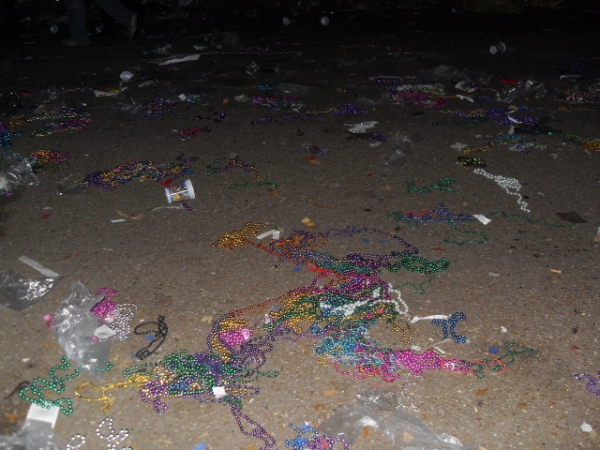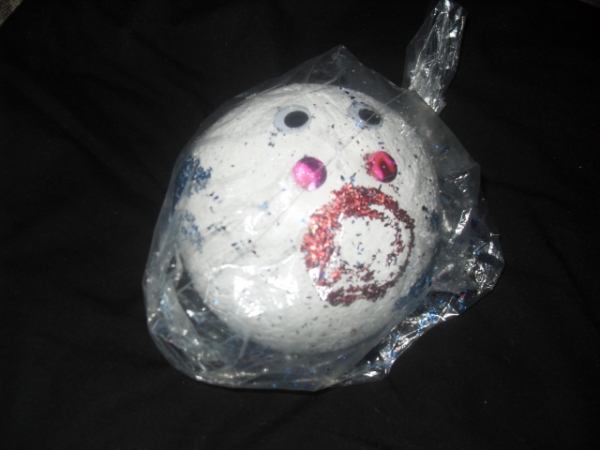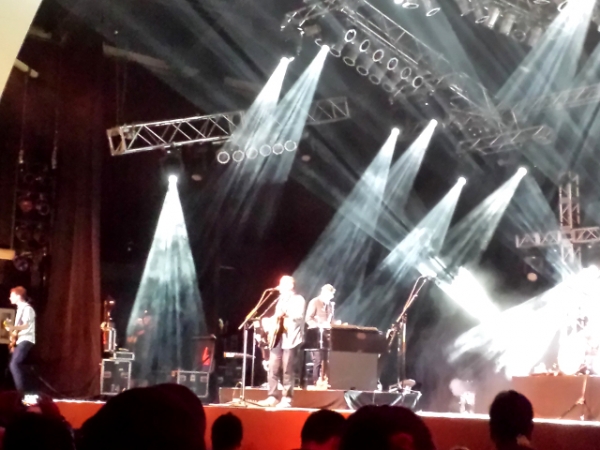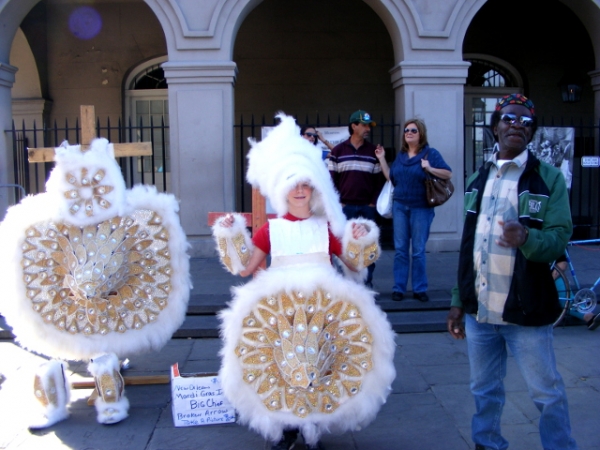Differences
1. Cleanliness
Although the sanitation company works very hard to remove the trash as soon as possible after the day’s parades roll, the reality is that New Orleans’ Mardi Gras generates a lot of refuse. With multiple parades along the same route each day, each lasting between 2 and 4 hours, and a notable lack of garbage cans, it is simply impossible for workers to keep things clean. The streets and sidewalks are soon littered with broken beads, cups, and other trash, which largely stays put until the end of the last parade of the day.
Universal holds a single parade each night, and it is significantly smaller in length and scope. Coupled with the numerous trash cans along the route and the high ratio of cleaning staff to guests, Universal remains surprisingly clean throughout the event. Whether this is a good or bad thing, of course, is up to each guest’s personal preferences. Personally, I feel like it’s not Mardi Gras without a good buildup of trash. But then, I hated the new sanitation company that New Orleans hired after Katrina, because they made the streets smell lemon fresh. So perhaps I’m not the best judge in that arena.
2. Variety of throws
Universal Orlando’s float riders do a great job of throwing beads and doubloons to the crowd. As the most well-known throws, these give parade-goers the feeling of being at an authentic Mardi Gras parade. For those who have been to New Orleans’ version, however, it can feel somewhat lacking.
In New Orleans, each krewe has both an overall theme and an annual theme. Krewe members work hard throughout the year acquiring throws that fit those themes, as well as extremely interesting but more general pieces. Small stuffed animals, toy footballs, and plastic cups are among the more common items, each tagged with the name of the krewe and often the year.
The all-female Krewe of Muses throws different variations of their signature item, the pink high-heeled shoe. Other krewes have their own signature pieces. But nothing is as highly prized as the Zulu coconut. Hollowed-out and hand painted, these used to be thrown into the crowd, until mounting injuries forced officials to make the practice illegal. Today, to receive a Zulu coconut, you must be chosen by a float rider, who will carefully hand the coconut down to you.
3. Big-name bands
In New Orleans, Mardi Gras is still very much a local party to which the world is invited. Some modern super-krewes, such as Endymion, choose big-name celebrity grand marshals each year, a fairly controversial practice that some feel flies in the face of tradition. In general, however, the entertainment is provided by a mix of local celebrities and top talent without a recognizable name. Big-name bands come to town all the time for other festivals, such as Jazz Fest and Satchmo, but Mardi Gras is something completely different.
Universal’s celebration is in some ways a mix of Mardi Gras and Jazz Fest. After sampling the cuisine, listening to lesser-known bands in an intimate setting, and enjoying the parade, guests rush to the outdoor stage to hear their favorite big-name performers. Although this in no way detracts from the event, it is a marked difference from how New Orleans does things.
4. Mardi Gras Indians
African-Americans and Native Americans have a long and complex history of friendship and loyalty in the New Orleans area. In the days of slavery, the Native American tribes living in the region assisted quite a few slaves in making their escape. With some of their own people having been captured as slaves in the early days of European settlement, they understood all too well the need to be free.
It was a West African tradition to dress like one’s hosts during a ritual celebration, and so the tradition of Black Indians was born. Wearing beautiful Native American ceremonial costumes, they began to celebrate their alliance during the Carnival season. Today’s Mardi Gras Indians are descendants of, and close friends with, those original Black Indians.
In New Orleans, the highly secretive Mardi Gras Indians work tirelessly all year to create elaborate, hand-made costumes decked out in feathers and beadwork. They compete each year to determine who is the prettiest. If you happen to see one, it is always appropriate to tell him how pretty he is.
The Mardi Gras Indian tradition is steeped in local New Orleans history, and could be seen as offensive to Universal visitors with no knowledge of the historical roots. So it is understandable that the park chose not to include them. Still, for those in the know, Mardi Gras without the Indians seems slightly empty.




Add new comment